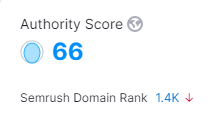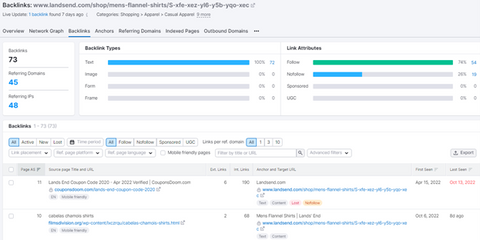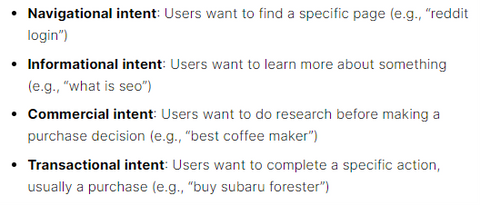Semrush is one of the most popular tools for doing the kind of research required to succeed with SEO.
But while it’s full of amazing features, our favorite is the Domani Overview report, which is amazing for conducting competitor analysis – FAST!
That’s because, as we recently covered in our breakdown of SEO tips for eCommerce stores, competitor analysis is what keeps you from making the costly mistake of recreating the wheel – starting from scratch and learning important lessons the hard way.
So, without further ado, let’s take a look at how you can use Semrush to find out what’s working best for your competition.
How to Check on Your Competitors with Semrush
The first step couldn’t be easier: identify your competition.
Chances are good that you already know who exactly that is. Maybe you even have their logo on a dartboard in your office (not judging).
Whatever the case, take their URL and enter it into Semrush’s Domain Overview tool:

Just enter the URL of the competitor you’re about to overtake.
Now, for this example (as in the video above), we’re just going to look at a single page of a single “competitor” website, but the principles we’ll explore can definitely be applied to entire sites. In this case, we’re imagining a situation where we need to improve a client’s webpage to beat one belonging to a competitor.
We’re going to use Semrush to do it and, in this case, the competitor page belongs to the perfectly respectful Land’s End:

Let’s dig in…
Understanding “Authority Score” in Semrush
The first thing you’ll notice on the resulting page is the “Authority Score”, which is basically the overall score Semrush is giving this competitor’s website (out of 100).

As I mention in the video above, this number is just a measurement from Semrush. It’s worth clicking on it and seeing what information Semrush is drawing on to make it, so that you can come to your own conclusions.
One of those big factors – and the ones we care about the most – is backlinks. I say we care about them the most because:
- We know backlinks are a ranking factor (at least for now) and if Google cares about it, we care about it
- We can potentially reach out to obtain backlinks from the same sources as the competition to even the playing field
So, let’s use Semrush to look at that.
How to Audit Your Competitors’ Backlinks with Semrush
The backlink report in Semrush is super user-friendly and easy to understand.
In short, it will show you where the backlinks for a particular page are coming from.
In this case, I’m not seeing any overly-impressive backlinks that I think we need to worry about in order to beat this page. It just doesn’t look like they’re the driving factor behind this page’s success.
It probably has more to do with the brand name (which we can’t do much about) and the website’s interlinks (which I’ll touch on at the end).

But here’s an important element to understand about this backlink report: it includes backlinks that no longer exist.
So, while it says this page has 73 backlinks above, if you select “Active” (below where it says “Backlinks 1 -73 (73)), you’ll see that the real number of backlinks currently pointing at this page is just 28.

This isn’t to say that “Lost” backlinks don’t matter. They can show you potential opportunities to reach out for backlinks to your own page.
However, when we’re only trying to get an idea for what it would take to beat the current version of a competitor’s webpage, I only care about their “Active” backlinks.
Checking Your Competitor’s Monthly Traffic with Semrush
Alright, now let’s get to the most important number Semrush can provide about this webpage: how much traffic they’re actually getting every month.
After all, if the answer is “two users”, we probably won’t be interested in investing a lot of time and money into creating a similar page.
As you can see from the screenshot above, the Domain Overview report tells us that this page is currently bringing in 3,400 users a month.
One important caveat here is that this is just an estimate. Ahrefs can’t possibly know just how many people are actually clicking on this page every month.
Interestingly, though, this number is almost exactly the same as the one I got when I used Ahrefs for competitor analysis the other week for this same page.
However, just like I mentioned in the video for that post, it’s a good idea to run some of your own pages through these platforms to see what their estimates are for your traffic. You can then compare them to the actual numbers from Google Analytics to get a good idea of how accurate they are. Nothing’s worse than getting the rankings you want from a new page only to find out that your prediction for traffic is woefully optimistic.

Click on this number and Semrush will show you exactly how this page is attracting all that traffic: its keywords!
How to Use Semrush for Keyword Research
Keyword research is one of the most important aspects of successfully ranking your site.
In fact, whenever companies hire us as eCommerce SEO consultants, one of their main requests is that we audit their attempts at identifying important keywords for their stores.
Semrush makes this much easier to do, especially when you start with a competitor in mind.
After you click on the aforementioned number underneath “Organic Search Traffic”, you’ll see the list of keywords that your competitor is ranking for with their page.

Let’s review the columns and then we’ll talk about one VERY important step you need to take to make the most of this report (most are self-explanatory):
- Keyword –This is just the phrase or term for which this page is ranking.
- Intent –Semrush tells you what kind of intention is behind people searching for these keywords with a single letter that corresponds to one of the following intentions:

However, just like I explained with Ahrefs, I really encourage you to take a second to search the term yourself to see what kinds of pages show up. As I showed in the video above, Semrush’s judgment can be off, but it’s EXTREMELY important that you’re not when deciding whether to make a category page, product page, service page, or blog post for each keyword.
- Positions –This is where the page ranks for the keyword when Semrush checked.
- Traffic –How much traffic the page gets for this keyword.
- Volume –The amount of searches the keyword gets every month.
- KD% –How difficult Semrush thinks it is to rank for this keyword. This is another example of when I would take the metric for a grain of salt and actually search for it to see what sites are ranking well in Google. For example, in this case, Semrush says “Lands End flannel” is “easy” to rank for, but as I show in the video above, the first page is CROWDED with websites that are going to be tough to beat.
- URL –These are the URLs for the page that is ranking for the keywords. If you run an analysis on an entire site, these URLs will all be different.
- SERP –Click this if you want to see where the page ranks in Google for the keyword. You can also just search for the term in Google, though.
- Updated –This is the last time Semrush updated its index for this information.
As I said, those were pretty self-explanatory, which is very much to Semrush’s credit. Their tool is very, very user-friendly, but that doesn’t make it any less helpful for doing effective keyword research.
The Extra Step You Need to Take When Doing Keyword Research in Semrush
That said, I want to add another caveat here.
When looking at keywords for a competitor’s keywords, it’s really important that you take that traffic number at face value. You need to remove any BRANDED keywords to really get a sense for what kind of traffic a similar page would get on your site.
Why?
Well, in the example we’ve been using, my page is never going to beat Land’s End for keywords that include their brand name. Never say never, but it’s just not very likely at all.
If you actually sell Land’s End products, it’s a little different. You could still rank on the first page, but again, you’re probably not going to beat the manufacturer.
On the other hand, if you’re only looking at their page because you also sell flannel shirts, rerun the keyword analysis with the brand name filtered out.

That will give you the following result:

1,800 clicks a month is still a lot, but it’s nearly half the amount this page gets thanks to branded keywords.
By removing them, we now have a much more accurate idea of what we can expect from building a similar page with similar keywords from our Semrush report.
Using the Keywords You Find in Semrush
So, now what?
Like I said earlier, I’d start at the keywords with the most search volume and work down the list until I find one that doesn’t look like there are too many big competitors hogging the first page.
Of course, you may find that there are no easy options. In that case, you’ll need to make a judgment call about an acceptable amount of competition.
Then, build the type of page your competitor has (in this case, a product page) to rank for that keyword.
Finally, - and this is especially true if you’re facing a lot of competition – build backlinks and relevant interlinks from other pages on your site to improve your chances of ranking.
How Good Is Semrush for Competitor Analysis?
The biggest drawback of using Semrush for doing your SEO research is that it doesn’t have the kind of user-friendly interlink tool you get with Ahrefs.
That kind of tool is essential for this type of research because if I see that a competitor has 100 ranking blog posts pointing at the page in question and using versions of the main keyword in their anchor text, I know that’s going to be really hard to beat. I’ll probably need a similar amount of blog posts to get the same results.
OTHER THAN THAT, there’s a reason Semrush is such a hugely popular SEO tool – and not just for competitor analysis. From keyword research to backlink analysis to overall site reporting, Semrush has a lot to offer.
If you’d like a more individualized recommendation, feel free to contact us to speak with one of our eCommerce experts.
